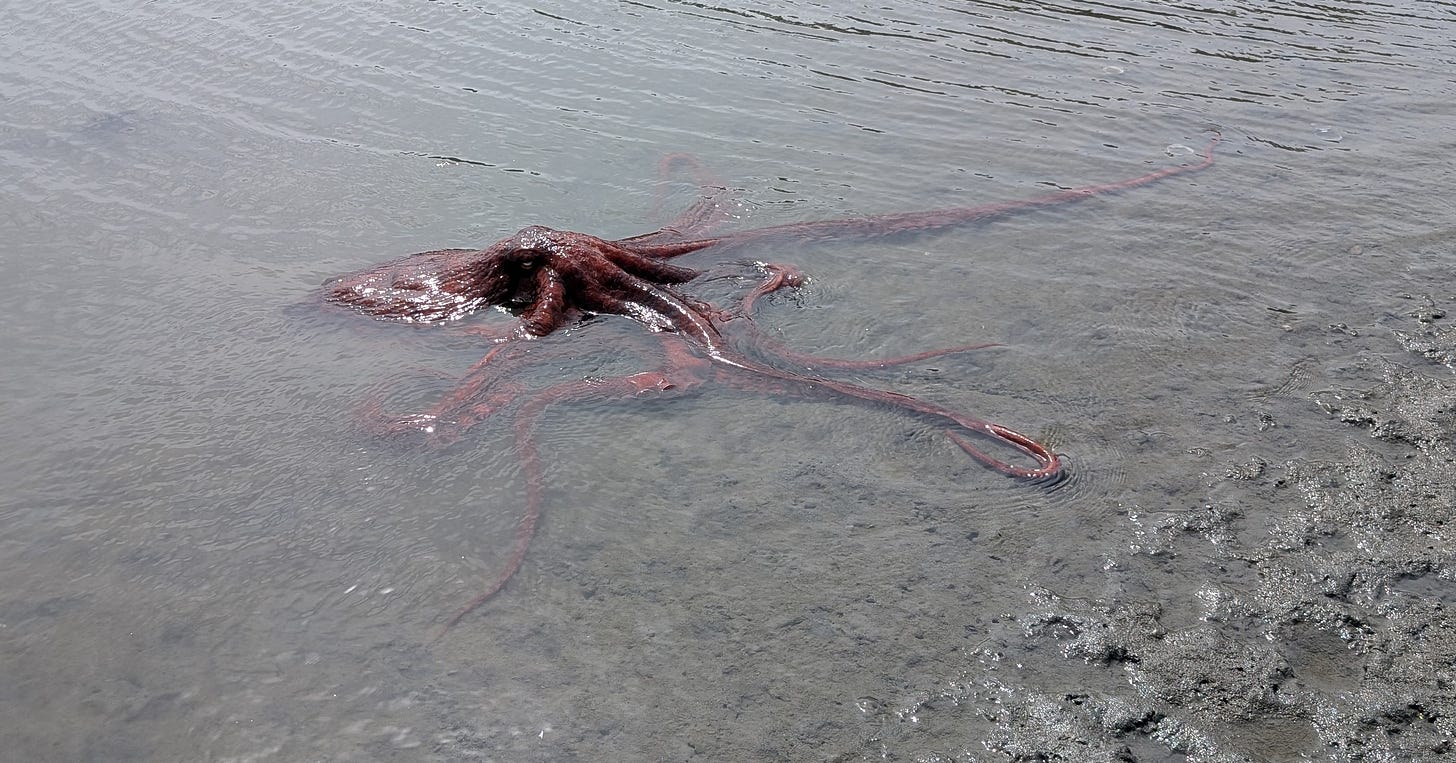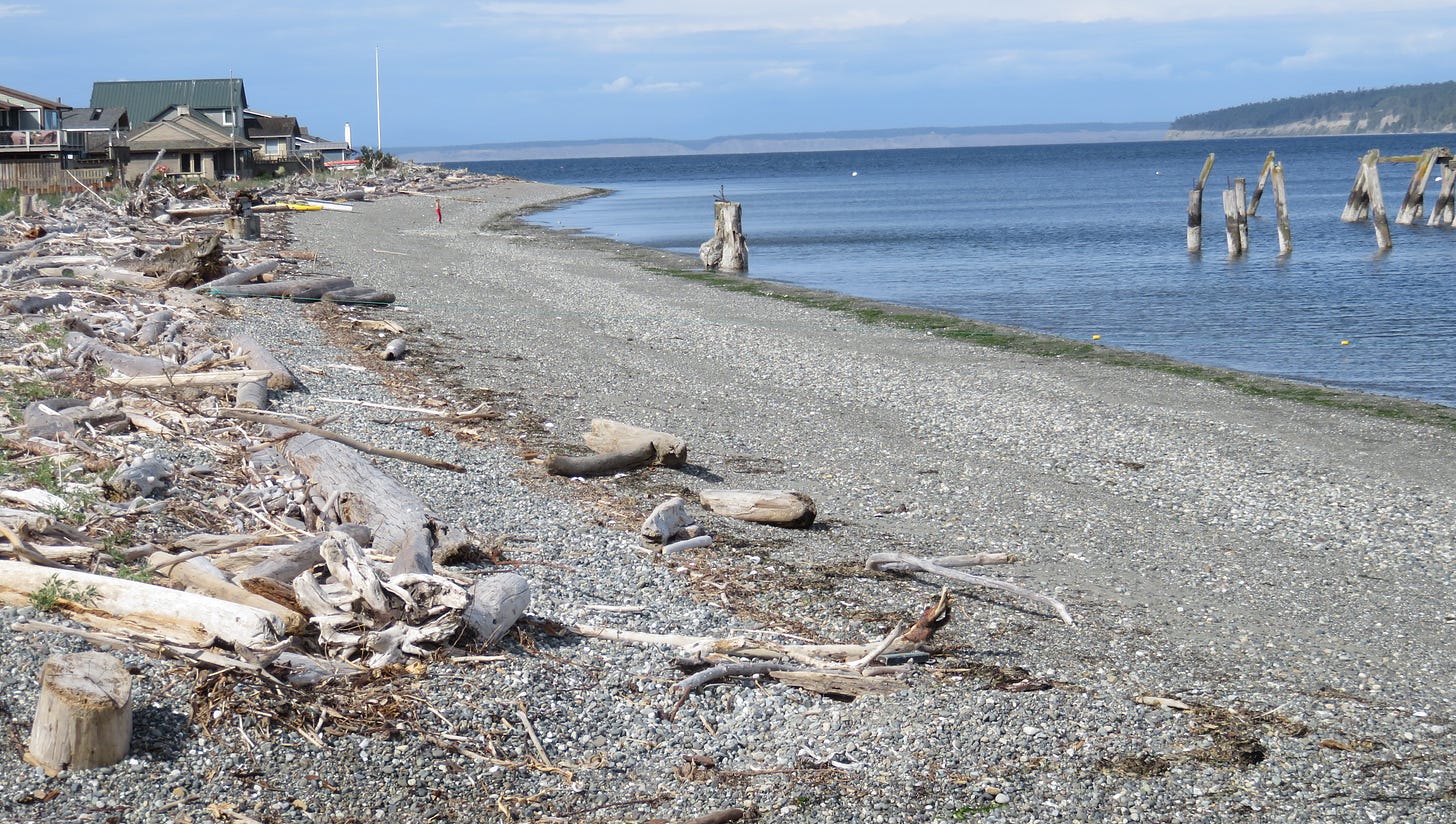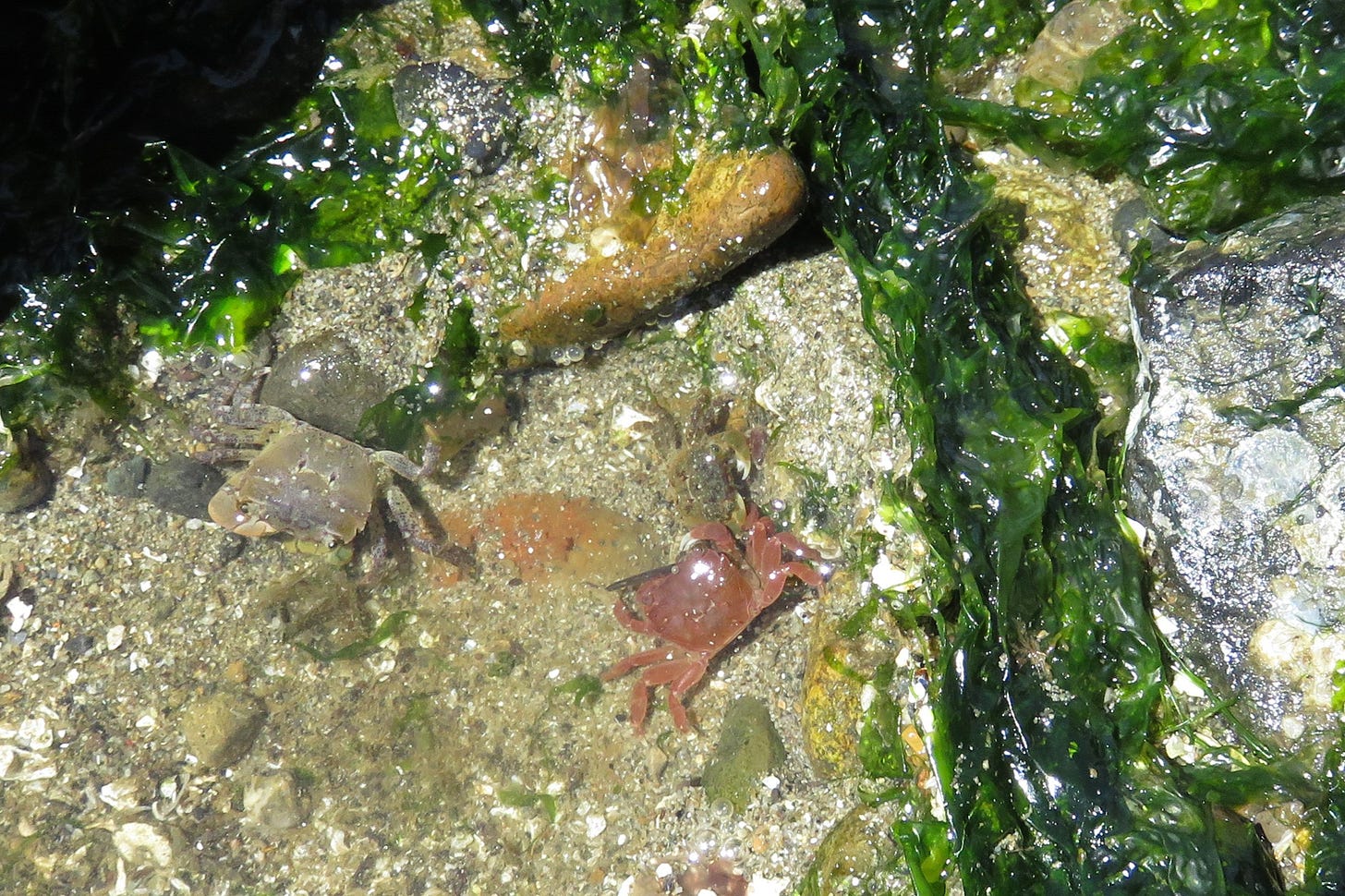The first time I ever set foot on a beach in Puget Sound was a typical spring day in Washington. I was helping another graduate student from the UW School of Fisheries test methods for clam farming on a pebbly beach in the south Sound. All my prior beach experience was on sandy North Carolina beaches, so the combination of some sand, more gravel, and mostly pebbles was novel and fascinating. The sun shone for a few minutes, then it rained for a few minutes, then more sunshine, then more rain, sunshine, rain, etc, on and off all afternoon. I had never experienced such on-again-off-again weather and remember thinking that it was very strange. Over the next six years of my PhD research, I spent many days on beaches of various kinds around Puget Sound, the Olympic Peninsula, and the outer coast. But until this summer, I hadn’t been back there in over forty years.
So it was with fond memories that I spent two weeks reexploring some of those beaches with my wife and daughter, her husband, and my 2+ year old grandson. They live in Switzerland, where beaches are scarce, so this was my grandson’s first experience with beaches, and really, with me as well. And he was only now figuring out who I was. We had visited about every six months since he was born, and every time, he exhibited a totally different persona. This was the first time he could actually walk, talk, and communicate with me, however faltingly. And since his parents speak four languages fluently between them, it often required parsing out which language he was speaking before trying to interpret it. But one word was unmistakable – “Grampa”.
The occasion was for my daughter and grandson to visit her grandmother (his great-grandmother) who is now 102 years old (no kidding!), and lives in Tacoma. But rather than spend two weeks in GGM’s house, which was not well prepared for the chaotic onslaught of a 2-year-old, we opted to spend a week in Sequim, out on the Olympic Peninsula, before spending another week in a rented house in Tacoma.
Though we could have driven directly there from the airport, I wanted to take the ferry from Seattle to Bainbridge Island. That was another fond memory that my daughter and her family had never experienced. And my grandson was delighted to explore the ferry, with his worried father following close behind. The simple pleasure of seeing so much water, and delighting in the other boats passing by, was evident on his face.
Our rental in Sequim was lovely, with a wide view of the Strait of Juan de Fuca. Then came the question: How does one entertain a 2.5-year-old in a rented house in a remote location for a week? Fortunately, our rental in Sequim was within walking distance of a small beach, on the appropriately named Discovery Bay, which consisted of more gravel than sand. On the first visit to the beach, grandson was a bit wobbly walking on the uneven substrate, but it didn’t take long to get his “beach legs”. We didn’t know what he would think of this cobbly strand, but he had so much fun just playing with the sand, gravel, and driftwood on the beach that we vowed to visit a different one every day. Which led to some interesting encounters and first experiences for all of us.
On that same beach we found oodles (that’s a scientific term for more than a bunch) of small crab carapaces, mostly shore crabs (genus Hemigrapsus) that had either died, or been molted, and washed up in the beach wrack. Once he was shown how to find them, my grandson had no trouble finding plenty more. So, one of his first new words (in English) was “Crab!”.
The second beach we visited was Dungeness Spit, a 5-mile-long sand spit that sticks out into the Strait of Juan de Fuca and is currently a nature reserve. There, I showed grandson how to build a sandcastle, or at least a pile of sand that could be loosely interpreted as a proto-castle in development. As we sat on the beach, we watched grebes and cormorants bobbing for fish, harbor seals poking their heads up to watch us, and listened to killdeer peep-peep-peeping at us from the protection of beach logs (a recording of which brackets the companion podcast).
Then my daughter saw a strange beast poke its head up to view us as it moved along in the shallows. Looking closely, we realized it was a giant Pacific Octopus Octopus dofleini. It came all the way up to the water’s edge, as if it was inspecting us, but more likely looking for some clams to eat. I’ve inspected plenty of octopus in my life, but never before had one come almost out of the water to inspect me.

One of the signature characteristics of beaches in Washington (or anywhere in the Northwest for that matter) is the amazing collection of driftwood and giant logs along the beaches. Virtually every beach has a pile of logs just above the high tide line. While many originated from storm erosion in rivers or along the coast, a lot of them are escapees from log rafts, that is, cut logs that were being transported by towing from a tug but then broke loose.
One of my fondest memories of Washington was building a beach fire with driftwood and sitting by it to watch the sunset. These memories are often tinged with nostalgia, though, because it seems like the times I did that were when I was between jobs, or grad school semesters, and had little else to do for a while. So, we set out one evening to build a beach fire.
Around the corner from our BnB, the local HOA had a private beach, to which we had a key during our stay. To it, we brought some obligatory supplies, including graham crackers, chocolate, and marshmallows, requirements for introducing our grandson to the mysteries of s’mores. Near the beach was a sign with too many rules, one of which was not to build fires above the high tide line. OK, that’s easy to comply with, I thought.
Within minutes I had a small pile of driftwood artfully arranged about 10 feet down-beach from the high tide line and soon had a roaring fire going. Grandson played in the sand as we adults watched the sunset and enjoyed our adult beverages. As the fire began to die, we placed foil-wrapped s’mores into the coals. As we did this, we noticed that the incoming tide was getting closer to the fire. Within about 15 minutes, water was lapping at the edges of our fire, causing the burning logs to hiss, crackle, and steam. After removing the first course of melted chocolate goop we tried making another, but by that time, some of our glowing embers were being carried away by the tide. My wife tried roasting a marshmallow over one of these, but it quickly drifted out of her reach. Oh well, at least we didn’t have to douse the flames, as the water soon covered our entire fire site.
One night we discovered an incredible restaurant (the Ajax Café) hidden in a tiny little cove called Port Hadley. After a delectable dinner of fresh, locally caught fish, I took my rambunctious grandson outside to a small beach to occupy him while the rest of the family finished up. What could I find to entertain him here, I wondered. I tried skipping rocks, but they were not flat enough to bounce. They did, however, make a nice “kerplunk!” sound as they hit the water. Soon, grandson and I were engaged in a rock tossing contest to see who could make the best splash. His attempts to throw a small rock mostly went wild, often landed at his feet, and occasionally in the water, to his great delight, regardless of where they fell.
Every time he leaned over to pick up a new rock, he picked up two and handed me one of them. I marveled at his thought process – one for me, and one for Grampa. We had great fun until it was time to go home. At every subsequent beach we visited, we had to have a rock tossing contest, and grandsonalways picked up two rocks, handing me one. As far as he was concerned, this game required both of us.
Another beach had some larger rocks on it, so I decided it was time to go tide-pooling. Turning over some of these, we began finding live shore crabs. grandson was fascinated by these, but not enough to hold one in his hand. As soon as I put back the rock (to protect the crabs and other under-rock biota), grandson wanted me to turn over another. The rocks were a bit too large for him to turn over, but he pointed out the ones he wanted me to inspect. After a while, he finally got brave enough to pick up the tiny crabs and hold them in his own hands. For him, this was a major step in both confidence and ability.
At some point during our stay, my daughter discovered and informed me about Molt Search. Like many coastal areas, Washington is suffering from an invasion of green shore crabs Carcinus maenus. They are endemic to Europe and probably arrived in US waters via ship ballast water. They were first seen in New England, then Southern California, and for the last several decades have been working their way down the east coast and up the west coast. In the east, they compete with blue crabs and lobster both for habitat and prey items, and in the west, they compete with Dungeness Crabs Cancer magister.
The Washington Sea Grant program had initiated a citizen-science project to find and detect the presence of invasive green crabs. Volunteers were encouraged to conduct beach surveys to find molts (empty shells) of green, Dungeness, and other crabs, according to a protocol on their website and report the data online. This would provide the best chance to reduce the spread and impact of this globally damaging invasive species. Additional data would help fill significant knowledge gaps on the range and growth patterns of Dungeness crabs, whose preferred habitats overlap with the new invader (and whose general biology was the subject of my PhD Dissertation). I was hooked.
And, I learned, they were promoting a mass survey event on June 20th that would cover the entire coastline of the Salish Sea (the current name for all the waters of Puget Sound, the Strait of Georgia, and the Strait of Juan de Fuca). And June 20 was tomorrow!
The next day, we went out for our daily beach visit, this time, back to our local beach in Sequim. Failing to interest my grandson in accompanying me, I conducted my survey alone by walking for 20 minutes along the line of beach wrack and collecting all the crab molts I could find. Afterwards, I spread them out, took a photo, then uploaded the photo to the website along with my search data (date, time, GPS coordinates, etc).
My collection included the shells of only one Dungeness crab (which was broken, so I could not measure it), nine red rock crabs Cancer productus, and 27 shore crabs (Hemigrapsus sp). I found not a single green crab, which is a good sign, at least for now.
A few days later it was time to depart. My wife was staying in Tacoma for another week with her mother, so I drove the rest of us back to SeaTac airport in the rental car, and we all took the shuttle to the airport. While my daughter and son-in-law ate lunch, I took grandson for a walk around the airport. That he trusted me enough to do this sans parents made me feel like a bond had been established. He led the way up one ramp and down another, holding onto one of my fingers, which he preferred to my much larger hand. We must have been a sight – an old bald graybeard being led around by a two-year-old – but we didn’t care. We were just enjoying each other’s company.
After saying our goodbyes, we all went to our separate departure gates. Flying home solo, I savored the two wonderful weeks during which I rediscovered some of my favorite Northwest beaches, while simultaneously discovering a new person at the same time he was discovering me. I will remember our time together in my few remaining years, but my grandson probably will not. I hope, though, that I have planted a seed, instilled in him a little appreciation for nature, for the outdoors, and for wildlife, that will blossom in the future. And I have a new favorite word – Grampa.
I can’t wait for our next opportunity to explore the outdoors together. And maybe someday, I will teach him to fish.
This issue of Ecologist at Large is available to all readers. However, if you would like to support my work with a one-off contribution, click “Buy me a coffee” below.







